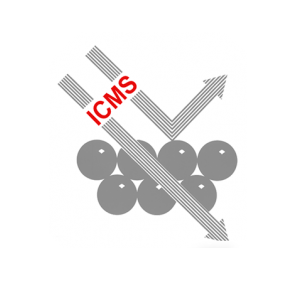Artículos SCI
2018
2018
Propiedades mecánicas, modelización y caracterización de cerámicos avanzados
Is an alumina-whisker-reinforced alumina composite the most efficient choice for an oxidation-resistant high-temperature ceramic?
Tamura, Y; Moshtaghioun, BM; Zapata-Solvas, E; Gomez-Garcia, D; Dominguez-Rodriguez, A; Cerecedo-Fernandez, C; Valcarcel-Juarez, VJournal of the European Ceramic Society, 38 (2018) 1812-1818 DOI: 10.1016/j.jeurceramsoc.2017.10.006
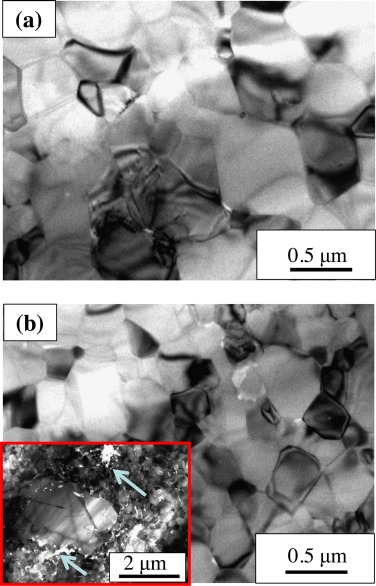
Abstract
The search of a competitive ceramic material for structural applications demands several requisites: a simple microstructure with easy reproducibility, good intrinsic mechanical properties and most of all, an optimal oxidation resistance. This later point is a challenging point for most ultrahigh refractory materials.
In this work an alumina (Al2O3) whisker-reinforced Al2O3 composite prepared by spark plasma sintering (SPS) is studied. It will be shown that, although the microstructure is quite similar to that of pure monolithic one, there is a notorious enhancement of the high-temperature deformation resistance, reaching up to one order of magnitude over the pure Al2O3 specimen. On the other hand, the activation energy of these composites increases notably. The results are explained in terms of an original model. A comparison with reported data shows that such composite is as efficient as a SiC-whisker-reinforced Al2O3 composite, with the advantage of its oxidation resistance and much less fabrication cost.
Abril, 2018 · DOI: 10.1016/j.jeurceramsoc.2017.10.006
Materiales y Procesos Catalíticos de Interés Ambiental y Energético
Bimetallic Ni-Co/SBA-15 catalysts for reforming of ethanol: How cobalt modifies the nickel metal phase and product distribution
Rodriguez-Gomez, A; Caballero, AMolecular Catalysis, 449 (2018) 122-130 DOI: 10.1016/j.mcat.2018.02.011

Abstract
In this study, five mono and bimetallic xNi-(10-x)Co/SBA-15 catalysts (x = 10, 8, 5, 2 and 0, with a total metallic content of 10 wt%) have been synthesized using a deposition-precipitation (DP) methodology. Catalytic performances on the steam reforming of ethanol reaction (SRE) have been determined and correlated with their physical and chemical state. A nickel content of 5% or higher yields catalytic systems with good activity, high selectivity to hydrogen and a low production of acetaldehyde (less than 5%). However, in the systems where the cobalt is the main component of the metallic phase (8-10%), the selectivity changes, mainly due to the production of an excess of acetaldehyde, which is also reflected in the larger H-2/CO2 ratio. In agreement with previous findings, this important modification in the selectivity comes from the formation of a cobalt carbide phase, where only takes place in the cobalt enriched systems, and is inhibited with nickel content larger than 5%. The formation of this carbide phase seems to be responsible for the decrease of cobalt particle size during the SRE reaction. Even though this cobalt carbide phase is thermodynamically metastable against decomposition to metallic cobalt and graphite carbon, our results have shown that it only reacts and decomposes after a hydrogen treatment at 600 degrees C.
Abril, 2018 · DOI: 10.1016/j.mcat.2018.02.011
Propiedades mecánicas, modelización y caracterización de cerámicos avanzados
Spark plasma sintering of titanium nitride in nitrogen: Does it affect the sinterability and the mechanical properties?
Moshtaghioun, BM; Gomez-Garcia, D; Dominguez-Rodriguez, AJournal of the European Ceramic Society, 38 (2018) 1190-1196 DOI: 10.1016/j.jeurceramsoc.2017.12.029
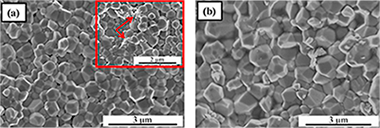
Abstract
Titanium nitride ceramics have an intrinsic interest due to its optical and structural applications. However, the conditions for sintering of dense pieces are not still clarified. This research work is focused on the spark plasma sintering (SPS) of near-fully dense fine-grained TiN. The main goal is giving a response to a longstanding debate: can the external atmosphere favor sintering? Different sintering atmospheres, either vacuum or a nitrogen flow, have been used during SPS heating to this purpose. X ray diffraction analysis has showed the presence of TiN as the main phase with traces of Ti4O7 in optimal SPS conditions (1600 °C, one minute dwell time). Our results show that the use of a nitrogen flow while heating can improve sinterability very slightly, but mechanical properties are essentially unaltered within the experimental uncertainty. The hardness reaches values as high as 20GPa whereas fracture toughness can be evaluated around 4 MPam1/2.
Abril, 2018 · DOI: 10.1016/j.jeurceramsoc.2017.12.029
Reactividad de Sólidos
Phase-pure BiFeO3 produced by reaction flash-sintering of Bi2O3 and Fe2O3
Gil-Gonzalez, E; Perejon, A; Sanchez-Jimenez, PE; Sayagues, MJ; Raj, R; Perez-Maqueda, LAJournal of Materials Chemistry A, 6 (2018) 5356-5366 DOI: 10.1039/c7ta09239c
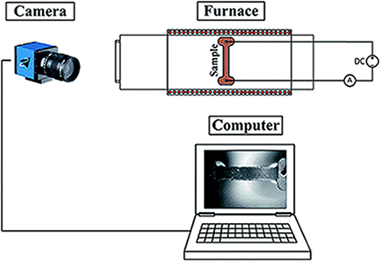
Abstract
Mixed powders of Bi2O3 and Fe2O3 are shown to yield single-phase, dense nanostructured polycrystals of BiFeO3 in reaction flash sintering experiments, carried out by applying a field of 50 V cm(-1) and with the current limit set to 35 mA mm(-2). The furnace was heated at a constant rate with the reaction sintering taking place abruptly upon reaching 625 degrees C. Remarkably, an intermediate bismuth-rich phase of the oxide that forms just before reaching the flash temperature transforms, and at the same time sinters, into singlephase BiFeO3 within a few seconds after the onset of the flash. The BiFeO3 so produced is electrically insulating, a property that is critical to its applications. This one-step synthesis of single-phase polycrystals of complex oxides from their basic constituents, by reaction flash sintering, is a significant development in the processing of complex oxides, which are normally difficult to sinter by conventional methods.
Abril, 2018 · DOI: 10.1039/c7ta09239c
Materiales de Diseño para la Energía y Medioambiente
Cesium adsorption isotherm on swelling high-charged micas from aqueous solutions: Effect of temperature
Osuna, FJ; Cota, A; Pavon, E; Pazos, MC; Alba, MDAmerican Mineralogist, 103 (2018) 623-628 DOI: 10.2138/am-2018-6203
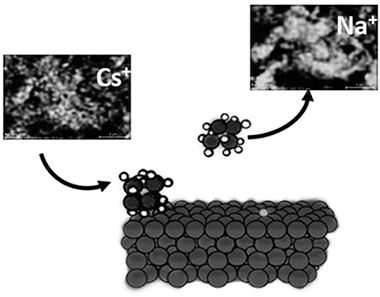
Abstract
The potential use of a new family of synthetic swelling micas for cesium immobilization from aqueous solution was evaluated and the structural modifications after adsorption were analyzed. The results have revealed that they are good cesium adsorbents compared to natural clays and as the layer charge increases, the adsorption capacity and affinity increase. The cesium ions are adsorbed through a cation exchange mechanism, but an inner sphere complex with the basal O atoms of the tetrahedral sheet is favored. These findings imply that is possible to design minerals with improved environmental applications.
Abril, 2018 · DOI: 10.2138/am-2018-6203
Materiales Coloidales
Photoluminescence quenching of dye molecules near a resonant silicon nanoparticle
Zyuzin, MV; Baranov, DG; Escudero, A; Chakraborty, I; Tsypkin, A; Ushakova, EV; Kraus, F; Parak, WJ; Makarov, SVScientific Reports, 8 (2018) art. 6107 DOI: 10.1038/s41598-018-24492-y
Abstract
Luminescent molecules attached to resonant colloidal particles are an important tool to study light-matter interaction. A traditional approach to enhance the photoluminescence intensity of the luminescent molecules in such conjugates is to incorporate spacer-coated plasmonic nanoantennas, where the spacer prevents intense non-radiative decay of the luminescent molecules. Here, we explore the capabilities of an alternative platform for photoluminescence enhancement, which is based on low-loss Mie-resonant colloidal silicon particles. We demonstrate that resonant silicon particles of spherical shape are more efficient for photoluminescence enhancement than their plasmonic counterparts in spacer-free configuration. Our theoretical calculations show that significant enhancement originates from larger quantum yields supported by silicon particles and their resonant features. Our results prove the potential of high-index dielectric particles for spacer-free enhancement of photoluminescence, which potentially could be a future platform for bioimaging and nanolasers.
Abril, 2018 · DOI: 10.1038/s41598-018-24492-y
Nanotecnología en Superficies y Plasma
Enhancing Moisture and Water Resistance in Perovskite Solar Cells by Encapsulation with Ultrathin Plasma Polymers
Idigoras, J; Aparicio, FJ; Contreras-Bemal, L; Ramos-Terron, S; Alcaire, M; Sanchez-Valencia, JR; Borras, A; Barranco, A; Anta, JAACS Applied Materials & Interfaces, 10 (2018) 11587-11594 DOI: 10.1021/acsami.7b17824
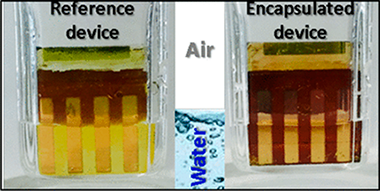
Abstract
A compromise between high power conversion efficiency and long-term stability of hybrid organic inorganic metal halide perovskite solar cells is necessary for their outdoor photovoltaic application and commercialization. Herein, a method to improve the stability of perovskite solar cells under water and moisture exposure consisting of the encapsulation of the cell with an ultrathin plasma polymer is reported. The deposition of the polymer is carried out at room temperature by the remote plasma vacuum deposition of adamantane powder. This encapsulation method does not affect the photovoltaic performance of the tested devices and is virtually compatible with any device configuration independent of the chemical composition. After 30 days under ambient conditions with a relative humidity (RH) in the range of 35-60%, the absorbance of encapsulated perovskite films remains practically unaltered. The deterioration in the photovoltaic performance of the corresponding encapsulated devices also becomes significantly delayed with respect to devices without encapsulation when vented continuously with very humid air (RH > 85%). More impressively, when encapsulated solar devices were immersed in liquid water, the photovoltaic performance was not affected at least within the first 60 s. In fact, it has been possible to measure the power conversion efficiency of encapsulated devices under operation in water. The proposed method opens up a new promising strategy to develop stable photovoltaic and photocatalytic perovskite devices.
Abril, 2018 · DOI: 10.1021/acsami.7b17824
Materiales Avanzados
Synthesis of vaterite CaCO3 as submicron and nanosized particles using inorganic precursors and sucrose in aqueous medium
Perez-Villarejo, L; Takabait, F; Mahtout, L; Carrasco-Hurtado, B; Eliche-Quesada, D; Sanchez-Soto, PJCeramics International, 44 (2018) 5291-5296 DOI: 10.1016/j.ceramint.2017.12.142
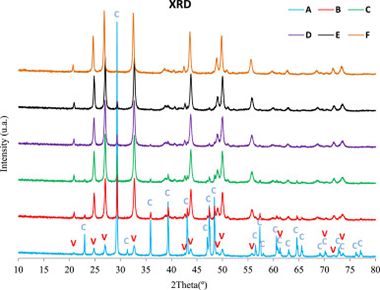
Abstract
It is reported the synthesis of CaCO3 vaterite as stable nanoparticles and submicron-sized by a simple and relatively rapid procedure. XRD, SEM and FTIR techniques have been used to characterize the precipitated products. The synthesis is based on chemical precipitation of inorganic salt precursors, calcium nitrate tetra hydrate and sodium bicarbonate, and using the disaccharide sucrose as an additive in aqueous medium. The role of the disaccharide sucrose is to control the vaterite precipitation after nucleation and growth. It has been found that an increase in sugar concentration promotes the crystal precipitation of vaterite with spherulitic morphology, as revealed by SEM, and changed the surface of the precipitated particles. There is a significant difference between CaCO3 precipitation in the absence and presence of sucrose. Addition of 0% of sucrose leads to 83% of calcite as identified by XRD methods. In contrast, addition of 67% of sucrose in aqueous medium produces 100% vaterite. The present results may be useful to provide a quick, simple, inexpensive and novel method for the controlled synthesis of new advanced biomaterials based on vaterite particles without hazardous chemicals and inert atmosphere, with great possibilities for industrial scale production.
Abril, 2018 · DOI: 10.1016/j.ceramint.2017.12.142
Nanotecnología en Superficies y Plasma
Electrophoretic deposition of mixed copper oxide/GO as cathode and N-doped GO as anode for electrochemical energy storage
Jafari, EA; Moradi, M; Hajati, S; Kiani, MA; Espinos, JPElectrochimica Acta, 268 (2018) 392-402 DOI: 10.1016/j.electacta.2018.02.122
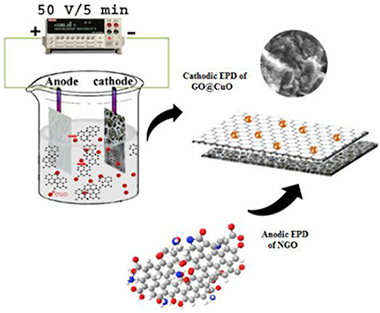
Abstract
In this work, energy storage properties of mixed copper oxide wrapped by reduced graphene oxide and nitrogen-doped reduced graphene oxide were investigated. First, co-electrophoretic deposition technique was used to coat GO@CuO on nickel foam; followed by electrochemical phase transformation to rGO@CuxO. Electron spectroscopy analyses (XPS, REELS and UPS) confirm the phase transformation and electrochemical reduction. Then, an electrophoretic deposition was carried out for coating nitrogen-doped graphene oxide on nickel foam coupled to its electrochemical reduction to the NrGO. The cathode and anode performances were studied by galvanostatic charge-discharge, cyclic voltammetry and impedance spectroscopy. The rGO@CuxO and NrGO exhibit a favorable specific capacity of 267.2 and 332.6 C g(-1) at 2 A g(-1), respectively. High electrochemical activity and elimination of polymer binders with a maximum potential of 1.6 V are among the advantages of rGO@CuxO//NrGO electrochemical charge storage device. Furthermore, fabricated device provided a maximum specific power and specific energy of 11917.24 W kg(-1) and 14.15 Wh kg(-1), respectively, with 86% capacity retention after 2000 cycles.
Abril, 2018 · DOI: 10.1016/j.electacta.2018.02.122
Reactividad de Sólidos
Self-propagating mechanosynthesis of HfB2 nanoparticles by a magnesiothermic reaction
Jalaly, M; Gotor, FJ; Sayagues, MJJournal of the American Ceramic Society, 101 (2018) 1412-1419 DOI: 10.1111/jace.15297
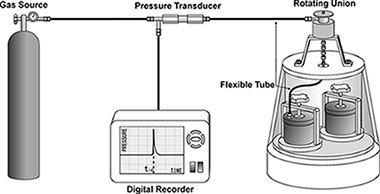
Abstract
A mechanically induced self-sustaining reaction (MSR) was used to synthesize hafnium diboride nanoparticles. Along this route, magnesium was selected as a robust reducing agent for co-reduction in boron and hafnium oxides in a combustive manner. Combustion occurred after a short milling period of 12 minutes. The hafnium diboride nanoparticles had a polygonal faceted morphology and were 50-250 nm in diameter. The assessment of the processing mechanism revealed that the initial combustive reduction in B2O3 to elemental B by Mg was the major step for progressing the overall reaction. After that, HfO2 can be reduced to elemental Hf, followed by the synthesis of HfB2 phase.
Abril, 2018 · DOI: 10.1111/jace.15297
Nanotecnología en Superficies y Plasma
Colorimetric energy sensitive scintillator detectors based on luminescent multilayer designs
Ferrer, FJ; Gil-Rostra, J; Gonzalez-Elipe, AR; Yubero, FSensors and Actuators A-Physical, 272 (2018) 217-222 DOI: 10.1016/j.sna.2018.01.062
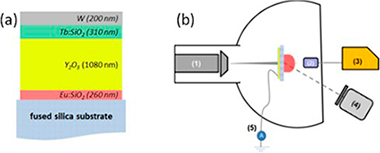
Abstract
In this work we present a new concept for energy sensitive radiation-beam scintillator detectors based on a luminescent multilayer design, where each layer within the stack consists of a rare-earth-doped highly transparent oxide. For a given type of particle beam (i.e., protons, a particles, etc.), its penetration depth, and therefore its energy loss at a particular buried layer, depends on its initial kinetic energy. Relying on this principle and since the intensity of the luminescent response of each layer and substrate should be proportional to the energy deposited by the radiation beam, we prove that a characteristic energy dependent color emission is obtained depending on both the phosphors integrated in the luminescent stack and on the primary energy and type of particle beam. Phosphor doping, emission efficiency, layer thickness, and multilayer structure design are key parameters to achieve a broad gamut in colorimetric response. The developed scintillators are designed to operate in a transmission geometry (light detection from the opposite side of the incident radiation) which is well suited for high energy particle detection in fields such as oncotherapy, space radiation, or of fusion studies. The principles of the method are illustrated with a case example typical of ion beam accelerators devoted to materials analysis. It is obtained that the kinetic energy of protons/alpha particle beams can be distinguished and evaluated with a sensitivity of 0.06/0.25 chromaticity units per MeV in the 0.7-2.0 MeV range.
Abril, 2018 · DOI: 10.1016/j.sna.2018.01.062
Materiales Coloidales
Synthesis and optical properties of environmentally benign and highly uniform NaCe(MoO4)(2) based yellow nanopigments
Laguna, M; Nuñez, NO; Fernandez, M; Ocaña, MJournal of Alloys and Compounds, 739 (2018) 542-548 DOI: 10.1016/j.jallcom.2017.12.158
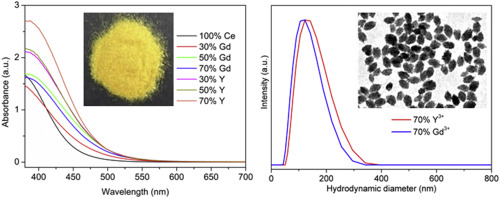
Abstract
A method for the synthesis of uniform and aggregation free NaCeMoO4 based nanospheroids with tunable size is reported. The procedure is based on a precipitation reaction at 120 degrees C for 20 h from solutions containing Na2MoO4, sodium citrate and Ce(NO3)(3) and different amounts of Y(NO3)(3) or Gd(NO3)(3). The role played by the later compounds on the formation of the particles and their morphological and structural characteristics is analyzed through the analysis of the mechanism of particle formation. The chromaticity coordinates of the obtained samples are also evaluated showing that the here reported nanoparticles constitute an ecofriendly alternative to more toxic commercial yellow pigments. The synthesized nanoparticles are also free of aggregation in water suspensions and might be suitable for injet-printing technologies.
Marzo, 2018 · DOI: 10.1016/j.jallcom.2017.12.158
Química de Superficies y Catálisis
CO2 reforming of methane over Ni-Ru supported catalysts: On the nature of active sites by operando DRIFTS study
Alvarez, A; Bobadilla, LF; Garcilaso, V; Centeno, MA; Odriozola, JAJournal of CO2 utilization, 24 (2018) 509-515 DOI: 10.1016/j.jcou.2018.01.027
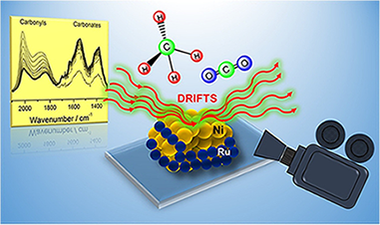
Abstract
The present paper addresses the nature of the active sites of a bimetallic Ni-Ru supported catalyst on the dry reforming of methane (DRM). The structural characterization by XRD and Raman spectroscopy, along with the reducibility study (TPR-H-2) of the samples, evidenced the existence of a strong Ni-Ru interaction in the bimetallic system. We have assumed that Ru atoms block the most reactive Ni sites (step-edge sites) leaving less reactive centers for methane activation (terraces). In this way, operando DRIFTS measurements revealed that Ru decreases the catalytic activity but favors the carbon gasification and prevents the CO dissociation.
Marzo, 2018 · DOI: 10.1016/j.jcou.2018.01.027
Materiales Avanzados
Investigation of use of coal fly ash in eco-friendly construction materials: fired clay bricks and silica-calcareous non fired bricks
Eliche-Quesada, D; Sandalio-Perez, JA; Martinez-Martinez, S; Perez-Villarejo, L; Sanchez-Soto, PJCeramics International, 44 (2018) 4400-4412 DOI: 10.1016/j.ceramint.2017.12.039
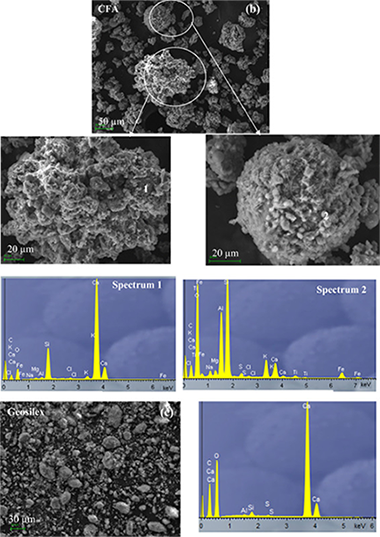
Abstract
The use of coal fly ash (CFA) as raw material for the manufacture of two construction materials, fired clay bricks and silica-calcareous non-fired bricks, was investigated. Fired clay bricks were manufactured using a commercial clay and different waste ratios (0-50 wt%), moulded at 10 MPa and fired at 1000 degrees C (4 h). Silica-calcareous non fired bricks were prepared using two wastes as raw material: CFA and "geosilex"(G), a hidrated lime residue which comes entirely from acetylene industry waste. Different proportions CFA (80-30 wt%) G (20-70 wt%) were investigated. Raw materials were moulded at 10 MPa and cured in water at room temperature during 28 days. The results indicated that the incorporation of up to 20 wt% of CFA produced fired clay bricks with physical and mechanical properties similar to control bricks without waste. However, additions of a higher amount (30-50 wt%) of residue resulted in a more pronounced decrease in mechanical properties (between 25-50%) due to an increase in open porosity. The technological characterization of the silica-calcareous non fired bricks showed a reduction in the values of bulk density and water absorption when the coal fly ash content decreases. Silica-calcareous non-fired bricks containing between 40 and 60 wt% of CFA had the highest values of compressive strength in the range 46-43 MPa. These silica-calcareous non-fired bricks, 60CFA-40 G, 50CFA-50 G and 40CFA-60 G, presented the optimum amount of pozzolanic materials (SiO2 and Al2O3) in the coal fly ash and calcium hydroxide in the geosilex to give rise to the formation of calcium silicate hydrates and calcium aluminate hydrates, the phases responsible for the mechanical resistance increase of the construction materials. Therefore, CFA-clay fired bricks and silica-calcareous CFA-Geosilex non-fired bricks presented optimal technological properties that attain the quality standards.
Marzo, 2018 · DOI: 10.1016/j.ceramint.2017.12.039
Química de Superficies y Catálisis
Epimerization of glucose over ionic liquid/phosphomolybdate hybrids: structure-activity relationship
Megias-Sayago, C; Alvarez, E; Ivanova, S; Odriozola, JAGreen Chemistry, 20 (2018) 1042-1049 DOI: 10.1039/c7gc03738d
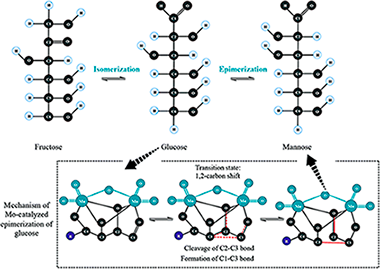
Abstract
The influence of the crystal structure and chemical nature of some ionic liquid/phosphomolybdate hybrids on their catalytic activity in the epimerization of glucose was studied. A clear evidence of structure-activity relationship was found. The inorganic part of the hybrid ensured the availability of active sites for the reaction, while the organic cation part organized the structure and controled the diffusion of the reactants. This study can be used as a first approach to predict the symmetry, long range order and availability of active sites in the presented class of imidazolium based polyoxometalate hybrids.
Marzo, 2018 · DOI: 10.1039/c7gc03738d
Nanotecnología en Superficies y Plasma
Dye Giant Absorption and Light Confinement Effects in Porous Bragg Microcavities
Oliva-Ramirez, M; Gil-Rostra, J; Simonsen, AC; Yubero, F; Gonzalez-Elipe, ARACS Photonics, 5 (2018) 984-991 DOI: 10.1021/acsphotonics.7b01283
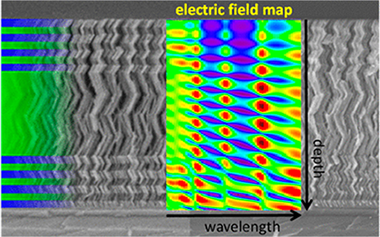
Abstract
This work presents a simple experimental procedure to probe light confinement effects in photonic structures. Two types of porous 1D Bragg microcavities with two resonant peaks in the reflection gap were prepared by physical vapor deposition at oblique angle configurations and then infiltrated with dye solutions of increasing concentrations. The unusual position shift and intensity drop of the transmitted resonant peak observed when it was scanned through the dye absorption band have been accounted for by the effect of the light trapped at their optical defect layer. An experimentally observed giant absorption of the dye molecules and a strong anomalous dispersion in the refractive index of the solution are claimed as the reasons for the observed variations in the Bragg microcavity resonant feature. Determining the giant absorption of infiltrated dye solutions is proposed as a general and simple methodology to experimentally assess light trapping effects in porous photonic structures.
Marzo, 2018 · DOI: 10.1021/acsphotonics.7b01283
Química de Superficies y Catálisis
LaFeO3 ceramics as selective oxygen sensors at mild temperature
Jaouali, I; Hamrouni, H; Moussa, N; Nsib, MF; Centeno, MA; Bonavita, A; Neri, G; Leonardi, SGCeramics International, 44 (2018) 4183-4189 DOI: 10.1016/j.ceramint.2017.11.221

Abstract
In this study, an investigation about the oxygen sensing properties of lanthanum orthoferrite (LaFeO3) ceramics is reported. LaFeO3 nanoparticles were synthesized by using tartaric sol-gel route and annealed in air at different temperatures (500, 700 and 900 degrees C). The samples have been characterized by using thermal analysis (TA), BET surface area and porosity, Fourier-transform infrared spectroscopy (FTIR), Raman spectroscopy, X-ray diffraction (XRD), and scanning electron microscopy (SEM). Results of sensing tests indicate that LaFeO3 nanoparticles exhibit good response to oxygen at mild temperatures (300-450 degrees C). The effect of annealing temperature on gas sensing performance was investigated, demonstrating that LaFeO3 ceramics obtained after annealing at 500 degrees C display better characteristics with respect to others. The oxygen sensor developed shows also high stability in humid environment and excellent selectivity to oxygen over other interfering gases such as CO, NO2, CO2, H-2 and ethanol.
Marzo, 2018 · DOI: 10.1016/j.ceramint.2017.11.221
Materiales Nanoestructurados y Microestructura
Biodegradabiliy of spherical mesoporous silica particles (MCM-41) in simulated body fluid (SBF)
Boccardi, E; Philippart, A; Beltran, AM; Schmidt, J; Liverani, L; Peukert, W; Boccaccini, ARAmerican Mineralogist, 103 (2018) 350-354 DOI: 10.2138/am-2018-6281
Abstract
Mesoporous silica particles of type MCM-41 (Mobile Composition of Matter No. 41), exhibiting highly ordered mesoporosity (pores with diameter between 2 and 50 nm) and surface roughness, are developed and used as a functional coating on bioactive glass-based scaffolds for bone tissue engineering. The degradability and the mesostructure stability of these novel MCM-41 particles were evaluated. The particles are immersed in simulated body fluid (SBF) for up to 28 days at 37 degrees C, and the variation of the ordered porosity, surface characteristics, and chemical composition of the particles are assessed by SEM-EDX, HRTEM, FTIR, ICP-OES, and pH measurements. The results indicate that the MCM-41 particles are affected by immersion in SBF only during the first few days; however, the surface and the mesopore structure of the particles do not change further with increasing time in SBF. The pore channel diameter increased slightly, confirming the stability of the developed material. The release of dissolved Si-species, which reached a maximum of 260 mg SiO2 per gram of material, could play a key role in gene activation of osteoblast cells and in inducing new bone matrix formation.
Marzo, 2018 · DOI: 10.2138/am-2018-6281
Materiales para Bioingeniería y Regeneración Tisular
Copper-containing mesoporous bioactive glass promotes angiogenesis in an in vivo zebrafish model
Romero-Sanchez, LB; Mari-Beffa, M; Carrillo, P; Medina, MA; Diaz-Cuenca, AActa Biomaterialia, 68 (2018) 272-285 DOI: 10.1016/j.actbio.2017.12.032

Abstract
The osteogenic and angiogenic responses of organisms to the ionic products of degradation of bioactive glasses (BGs) are being intensively investigated. The promotion of angiogenesis by copper (Cu) has been known for more than three decades. This element can be incorporated to delivery carriers, such as BGs, and the materials used in biological assays. In this work, Cu-containing mesoporous bioactive glass (MBG) in the SiO2-CaO-P2O5compositional system was prepared incorporating 5% mol Cu (MBG-5Cu) by replacement of the corresponding amount of Ca. The biological effects of the ionic products of MBG biodegradation were evaluated on a well-known endothelial cell line, the bovine aorta endothelial cells (BAEC), as well as in an in vivo zebrafish (Danio rerio) embryo assay. The results suggest that ionic products of both MBG (Cu free) and MBG-5Cu materials promote angiogenesis. In vitro cell cultures show that the ionic dissolution products of these materials are not toxic and promote BAEC viability and migration. In addition, the in vivo assay indicates that both exposition and microinjection of zebrafish embryos with Cu free MBG material increase vessel number and thickness of the subintestinal venous plexus (SIVP), whereas assays using MBG-5Cu enhance this effect.
Marzo, 2018 · DOI: 10.1016/j.actbio.2017.12.032
Química de Superficies y Catálisis
Tailoring structured WGS catalysts: Impact of multilayered concept on the water surface interactions
Gonzalez-Castano, M; Le Sache, E; Ivanova, S; Romero-Sarria, F; Centeno, MA; Odriozola, JAApplied Catalysis B-Environmental, 222 (2018) 124-132 DOI: 10.1016/j.apcatb.2017.10.018
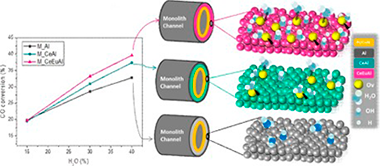
Abstract
A novel multilayer approach for designing structured WGS catalyst is employed in this study as a response to the lack of new strategies in the literature. The approach proposes the use of two successive layers with different functionalities on metallic micromonolith substrate. The WGS catalyst behavior is modulated by the nature of the inner layer which determines the active species surface population by acting on the water activation step. The catalytic promotion attained by introducing inner ceria containing solids with increasing number of oxygen defects is intensely analyzed through FT-IR and H2O-TPD. Several evidences about the participation of the oxygen vacancies, as key sites, for water absorption processes are established. Besides, remarkable relationships between the water absorption strengths and the water splitting processes within their influence on the catalyst performance are also discussed.
Marzo, 2018 · DOI: 10.1016/j.apcatb.2017.10.018
Química de Superficies y Catálisis
Numerical study of the accuracy of temperature measurement by thermocouples in small-scale reactors
Blay, V; Bobadilla, LFChemical Engineering Research & Design, 131 (2018) 545-556 DOI: 10.1016/j.cherd.2017.06.003
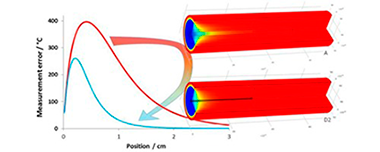
Abstract
Proper temperature measurement is imperative in any laboratory study if reliable data are to be obtained, particularly in the field of chemical kinetics. In this paper we analyze in silico some typical thermowell configurations used in small-scale reactors by coupling computational fluid dynamics (CFD) with conjugated heat transfer phenomena. This allows us to identify deviations in measurements arising from thermal radiation and self-conductivity in mid and high temperature ranges, in addition to radial temperature gradients. A novel design is proposed and optimized by additional simulation, showing potential for faster and more accurate temperature measurements.
Marzo, 2018 · DOI: 10.1016/j.cherd.2017.06.003
Nanotecnología en Superficies y Plasma
Robust polarization active nanostructured 1D Bragg Microcavities as optofluidic label-free refractive index sensor
Oliva-Ramirez, M; Gil-Rostra, J; Yubero, F; Gonzalez-Elipe, ARSensors and Actuators B-Chemical, 256 (2018) 590-599 DOI: 10.1016/j.snb.2017.10.060
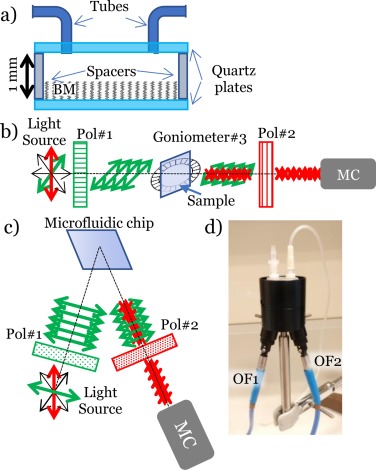
Abstract
In this work we report the use of polarization active porous 1D Bragg microcavities (BM) prepared by physical vapor deposition at oblique angles for the optofluidic analysis of liquid solutions. These photonic structures consist of a series of stacked highly porous layers of two materials with different refractive indices and high birefringence. Their operational principle implies filling the pores with the analyzed liquid while monitoring with linearly polarized light the associated changes in optical response as a function of the solution refractive index. The response of both polarization active and inactive BMs as optofluidic sensors for the determination of glucose concentration in water solutions has been systematically compared. Different methods of detection, including monitoring the BM wave retarder behavior, are critically compared for both low and high glucose concentrations. Data are taken in transmission and reflection modes and different options explored to prove the incorporation of these nanostructured transducers into microfluidic systems and/or onto the tip of an optical fiber. This analysis has proven the advantages of the polarization active transducer sensors for the optofluidic analysis of liquids and their robustness even in the presence of light source instabilities or misalignments of the optical system used for detection.
Marzo, 2018 · DOI: 10.1016/j.snb.2017.10.060
Química de Superficies y Catálisis
Synthesis of Pd-Al/biomorphic carbon catalysts using cellulose as carbon precursor
Cazana, F; Galetti, A; Meyer, C; Sebastian, V; Centeno, MA; Romeo, E; Monzon, ACatalysis Today, 301 (2018) 226-238 DOI: 10.1016/j.cattod.2017.05.026
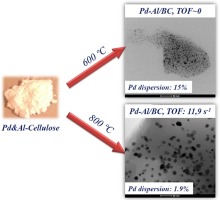
Abstract
This work presents the results obtained with novel Pd and Pd-Al catalysts supported on carbon, which have been prepared using a biomorphic mineralization technique. The catalyst synthesis procedure includes a stage of thermal decomposition under reductive atmosphere of cellulose previously impregnated with the metallic precursors. We have studied the influence of the temperature and time of decomposition, and of the Al precursor addition, on the textural and catalytic properties. The characterisation results indicate that the preparation method used leads to the formation of carbonaceous supports with a high microporosity (up to 97% micropore volume) and values of the BET surface up to 470 m2/g while maintaining the original external structure. The use of low temperatures (ca. 600 °C) during the decomposition step allows the preparation of highly dispersed catalysts with narrow Pd particle size distributions. However, the thermal decomposition at elevated temperatures (ca. 800 °C) increases the Pd particle size due to the sintering of the metallic phase. This phenomenon is augmented with the decomposition time and is not affected by the presence of Al. Consequently, the catalytic activity of these materials in cyclohexene hydrogenation is strongly affected by the operational conditions used during the thermal decomposition step. Unexpectedly, the more sintered catalysts, i.e. those prepared at 800 °C, show the highest activity. According to the characterization results, this fact can be explained considering that the smaller Pd particles obtained after preparation at e.g. 600 °C are quite inactive because they are confined in the internal structure of the micropores of the support and/or embedded inside the carbon matrix. In contrast, after decomposition at 800 °C, the larger Pd particles formed are placed at the external surface of the catalyst, being accessible to the reactants. In addition, for the specific conditions under which the Pd is accessible, the presence of Al favours the cyclohexene conversion due to the enhancement of the adsorption on the Pd surface as a consequence of a charge transfer phenomenon. These results can serve as a guideline for the preparation of these catalysts based on raw lignocellulosic materials in order to maximize their catalytic performance.
Marzo, 2018 · DOI: 10.1016/j.cattod.2017.05.026
Química de Superficies y Catálisis
Gold catalyst recycling study in base-free glucose oxidation reaction
Megias-Sayago, C.; Bobadilla, L. F.; Ivanova, S.; Penkova, A.; Centeno, M. A.; Odriozola, J. A.Catalysis Today, 301 (2018) 72-77 DOI: 10.1016/j.cattod.2017.03.022

Abstract
This work is devoted to the study of viability of immobilized gold colloids on carbon as catalysts for the base-free glucose oxidation reaction with a special emphasis made on catalysts' recycling, operational life and possible routes for deactivation/reactivation under batch conditions. The observed catalytic behavior is related to all possible manners of deactivation, like gold metal state changes (particle size agglomeration or leaching), support modifications or active sites blocking by intermediates. In an attempt to recover the initial catalytic activity, the samples are subjected to different treatments such as H2O and NaOH washings and calcination. The failure of the regeneration procedures to recover the initial activity and after detailed catalyst' characterization allows us to find out the main cause of deactivation
Marzo, 2018 · DOI: 10.1016/j.cattod.2017.03.022
Materiales de Diseño para la Energía y Medioambiente
Experimental measurement of the filtration efficiency and pressure drop of wall-flow diesel particulate filters (DPF) made of biomorphic Silicon Carbide using laboratory generated particles
Orihuela, MP; Gomez-Martin, A; Miceli, P; Becerra, JA; Chacartegui, R; Fino, DApplied Thermal Engineering, 131 (2018) 41-53 DOI: 10.1016/j.applthermaleng.2017.11.149
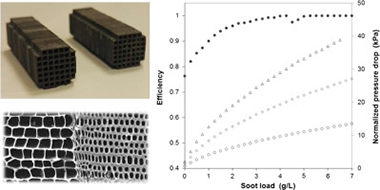
Abstract
Biomorphic Silicon Carbide (bioSiC) has been recently introduced in the scope of porous ceramic substrates for hot gas filtration applications, where it has demonstrated to have good thermal and mechanical properties, and a high potential to meet the requirements for current Diesel Particulate Filters (DPF). In this experimental study, a small wall-flow bioSiC diesel filter was characterized using a soot generator, the particle size distribution of which being similar to the one generated by a diesel engine. The bioSiC samples were manufactured from Medium Density Fiberboard (MDF) following a general manufacturing procedure for bioSiC ceramics, but paying special attention in the mechanizing stage to the geometry and optimal design of the honeycomb structure required for diesel engine applications. The samples had a cell density of 57.59 cell/cm(2) (371.6 cpsi), a square cross section of 9.2 x 9.2 mm, and a length of 31 mm. To generate the particle laden stream and perform the filtration tests, a synthetic Soot Generator (SG) was used. Tests were performed under controlled and reproducible conditions, with a fixed gas flow rate of 5 LPM and a soot mass flow rate of 4 mg/h. The filtration efficiency was determined with the aid of a Scanning Mobility Particle Sizer (SMPS) from the measurements of the particle concentration upstream and downstream the filter samples. During the soot loading process, the pressure drop was also monitored. The results show that, in the initial stage (clean filter), bioSiC wall-flow DPFs may have a filtration efficiency between 0.7 and 0.85 and a pressure drop of around 2 kPa for a normalized wall velocity of 0.01 m/s at ambient temperature. The filtration performance of wall-flow bioSiC particle filters showed in this work can help us to better understand their real potential for automotive applications.
Febrero, 2018 · DOI: 10.1016/j.applthermaleng.2017.11.149
Materiales Coloidales
Laterally and Temporally Controlled Intracellular Staining by Light-Triggered Release of Encapsulated Fluorescent Markers
Kantner, K; Rejman, J; Kraft, KVL; Soliman, MG; Zyuzin, MV; Escudero, A; del Pino, P; Parak, WJChemistry-A European Journal, 24 (2018) 2098-2102 DOI: 10.1002/chem.201706135
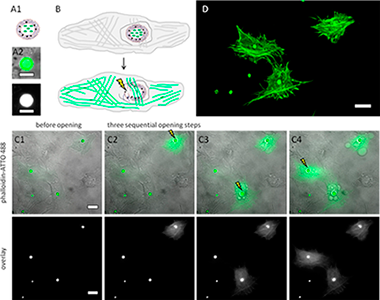
Abstract
Fluorescent molecular markers were encapsulated. The capsules were additionally modified with plasmonic nanoparticles. The encapsulated markers were endocytosed by cells. Upon light stimulation the plasmonic nanoparticles generated heat, which opened the encapsulation and transiently perforated the endosomal/lysosomal membrane surrounding the capsule, thus allowing for release of the marker into the cytosol. Fluorescence labeling of different intracellular compartments was demonstrated in this way. Most important, the cells do not need to be fixed and perforated, as the molecular markers are introduced into cells by endocytosis and subsequent light-induced release. Thus this technique allows for intracellular fluorescence labeling of living cells.
Febrero, 2018 · DOI: 10.1002/chem.201706135
Reactividad de Sólidos
Effect of Basicity on the Hydrolysis of the Bi(III) Aqua Ion in Solution: An Ab Initio Molecular Dynamics Study
Ayala, R; Martinez, JM; Pappalardo, RR; Refson, K; Marcos, ESJournal of Physical Chemistry A, 122 (2018) 1905-1915 DOI: 10.1021/acs.jpca.7b12402
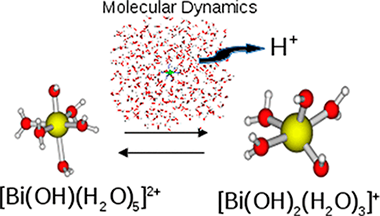
Abstract
Hydrolysis of the Bi(III) aqua ion under a range of solution conditions has been studied by means of ab initio molecular dynamics simulations. While the Bi(III) aqua ion is stable in pure water, there is an increasing degree of hydrolysis with the number of hydroxide anions in the medium. This is accompanied by a monotonic decrease of the total coordination number to an asymptotic value of similar to 6, reached under extreme basicity conditions. Comparison of the simulated Bi(III) hydrolyzed species with the experimental species distribution at different degrees of basicity suggests that, at the PBE/DFT level of theory here employed, liquid water shows an overly acidic character. Predictions of theoretical EXAFS and XANES spectra were generated from the AIMD trajectories for different Bi hydrolyzed species, [Bi(HO)(m)(H2O)(n)](3-m+), m = 0-3 and n = 7-2. Comparison with available experimental spectra is presented. Spectral features joined to the degree of hydrolysis and hydration are analyzed.
Febrero, 2018 · DOI: 10.1021/acs.jpca.7b12402
Nanotecnología en Superficies y Plasma - Tribología y Protección de Superficies
Self-Assembly of the Nonplanar Fe(III) Phthalocyanine Small-Molecule: Unraveling the Impact on the Magnetic Properties of Organic Nanowires
Filippin, AN; Lopez-Flores, V; Rojas, TC; Saghi, Z; Rico, VJ; Sanchez-Valencia, JR; Espinos, JP; Zitolo, A; Viret, M; Midgley, PA; Barranco, A; Borras, AChemistry of Materials, 30 (2018) 879-887 DOI: 10.1021/acs.chemmater.7b04515
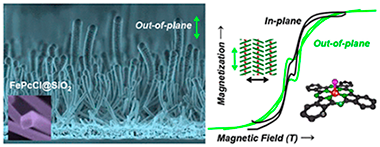
Abstract
In this article we show for the first time the formation of magnetic supported organic nanowires (ONWs) driven by self-assembly of a nonplanar Fe(III) phthalocyanine chloride (FePcCl) molecule. The ONWs grow by a crystallization mechanism on roughness-tailored substrates. The growth methodology consists of a vapor deposition under low vacuum and mild temperature conditions. The structure, microstructure, and chemical composition of the FePcCl NWs are thoroughly elucidated and compared with those of Fe(II) phthalocyanine NWs by a consistent and complementary combination of advanced electron microscopies and X-ray spectroscopies. In a further step, we vertically align the NWs by conformal deposition of a SiO2 shell. Such orientation is critical to analyze the magnetic properties of the FePcCl and FePc supported NWs. A ferromagnetic behavior below 30 K with an easy axis perpendicular to the phthalocyanine plane was observed in the two cases with the FePcCl nanowires presenting a wider hysteresis. These results open the path to the fabrication of nanostructured one-dimensional small-molecule spintronic devices.
Febrero, 2018 · DOI: 10.1021/acs.chemmater.7b04515
Nanotecnología en Superficies y Plasma
In situ monitoring of the phenomenon of electrochemical promotion of catalysis
Espinos, JP; Rico, VJ; Gonzalez-Cobos, J; Sanchez-Valencia, JR; Perez-Dieste, V; Escudero, C; de Lucas-Consuegra, A; Gonzalez-Elipe, ARJournal of Catalysis, 358 (2018) 27-34 DOI: 10.1016/j.jcat.2017.11.027

Abstract
In this work we investigate by in-situ near-ambient pressure photoemission (NAPP) spectroscopy the phenomenon of Electrochemical Promotion of Catalysis (EPOC). We studied the reduction and diffusion kinetics of alkaline ions in a solid electrolyte cell formed by a nickel electrode supported on K+-beta-alumina electrolyte. Experiments in ultra-high vacuum and in the presence of steam showed that the amount of potassium atoms supplied to the surface is probably affected by nickel electronic modifications induced by adsorbed OH- groups. It was also deduced that part of the segregated potassium would be adsorbed at inner interfaces where it would be inaccessible to the photoelectron analyzer. A migration mechanism of the promoter is proposed consisting in: (i) the electrochemical reduction of the alkali ions (potassium) at the Ni/solid electrolyte/gas interface; (ii) the spillover of potassium atoms onto the Ni gas-exposed surface; and (iii) the diffusion of potassium atoms to Ni inner grain boundary interfaces.
Febrero, 2018 · DOI: 10.1016/j.jcat.2017.11.027
Reactividad de Sólidos
Calcium-Looping performance of mechanically modified Al2O3-CaO composites for energy storage and CO2 capture
Benitez-Guerrero, M; Valverde, JM; Sanchez-Jimenez, PE; Perejon, A; Perez-Maqueda, LAChemical Engineering Journal, 334 (2018) 2343-2355 DOI: 10.1016/j.cej.2017.11.183

Abstract
This work reports the Calcium-Looping (CaL) multicycle performance under energy storage and CO2 capture conditions of different Al-composites prepared by milling mixtures of nanoalumina and natural limestone powders. The micro-and nanostructure of the composites have been analyzed by X-ray diffraction, scanning electron microscopy and high-resolution transmission electron microscopy as affected by the type of CaL conditions employed, either for energy storage in Concentrated Solar Power (CSP) plants or for post-combustion CO2 capture. Two types of calcium aluminates are formed under these diverse CaL conditions. A calcium aluminate with ratio Ca/Al < 1 (Ca4Al6O13) is formed under CaL-CSP conditions, which helps stabilize the CaO microstructure and mitigate pore-plugging. On the other hand, a crystalline phase Ca3Al2O6 is formed (Ca/Al > 1) under CaL-CO2 capture conditions presumably due to the higher calcination temperature, which withdraws from the sorbent a relatively higher amount of active Ca. Moreover, the addition of nano-alumina, and the consequent generation of calcium aluminate, affects in a diverse way the microstructure and morphology of the CaO particles as depending on the CaL application, which critically modifies the performance of the composites.
Febrero, 2018 · DOI: 10.1016/j.cej.2017.11.183
Materiales y Procesos Catalíticos de Interés Ambiental y Energético
Improving the direct synthesis of hydrogen peroxide from hydrogen and oxygen over Au-Pd/SBA-15 catalysts by selective functionalization
Rodriguez-Gomez, A; Platero, F; Caballero, A; Colon, GMolecular Catalysis, 445 (2018) 142-151 DOI: 10.1016/j.mcat.2017.10.034
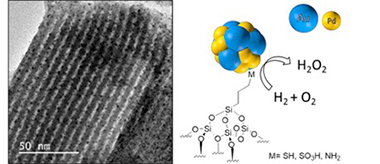
Abstract
A series of gold-palladium catalysts supported in a mesoporous surface functionalized silica SBA-15 was studied for H2O2 direct synthesis. Support functionalization was performed using different organic groups (namely-SO3H, -NH2 and-SH) while metal was then supported by an ion exchanged method. Different Au-Pd/SBA-15 catalysts were tested in the Direct Synthesis of Hydrogen Peroxide (DSHP). Organic functional groups (-SH, -SO3H and-NH2) with acid-base properties acted as anchoring sites controlling both the dispersion of the metallic active phase and the chemical state of gold and palladium species as Au+ and Pd2+, respectively. Compared to a Au-Pd/SBA-15 system prepared by incipient wetness impregnation over non-functionalized SBA-15, catalytic performance is improved upon functionalization, increasing hydrogen peroxide rate in sulfonic-SBA-15 systems and reducing the hydrogenation/decomposition activity by adding amine groups. The occurrence of amine groups clearly suppresses the support microporosity and probably condition the metal cluster size. The analysis of particle size by TEM showed that sulfonated samples lead to a Pd size compromise which improves the H2O2 production hindering the competitive side reactions, particularly suppressed by the presence of amine groups.
Febrero, 2018 · DOI: 10.1016/j.mcat.2017.10.034
Reactividad de Sólidos - Fotocatálisis Heterogénea: Aplicaciones
High {0 0 1} faceted TiO2 nanoparticles for the valorization of oxygenated compounds present in aqueous biomass-derived feedstocks
Fernández-Arroyo, A.; Lara, M.A.; Domine, M.E.; Sayagués, M.J.; Navío, J.A.; Hidalgo, M.C.Journal of Catalysts, 358 (2018) 266-276 DOI: 10.1016/j.jcat.2017.12.018
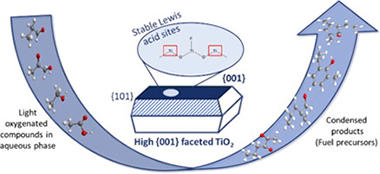
Abstract
{0 0 1} faceted TiO2 catalysts are hydrothermally synthesized by using titanium(IV) isopropoxide and butoxide precursors (ISO and BUT TiO2samples) together with HF addition. Their activity and stability are evaluated in the catalytic condensation of light oxygenated organic compounds present in an aqueous model mixture simulating a real bio-refinery effluent, under moderate operation conditions. High {0 0 1} faceted TiO2 catalysts show organic products yields superior to those attained with other TiO2 samples (anatase, rutile, and P25). This enhanced catalytic activity relates to their physico-chemical and textural properties, such as high surface area (≈100 m2/g), regular morphology (platelets conformed by partially agglomerated TiO2 nanoparticles), and adequate Lewis acidity. XRD and Raman measurements evidence the unique presence of anatase crystalline phase in both ISO and BUT materials, in which the use of HF during synthesis produces the preferential growth of TiO2 crystals mainly exposing the {0 0 1} plane. This effective {0 0 1} facet exposition directly determines catalytic results. Moreover, TiO2 ISO catalyst shows outstanding stability under reaction conditions, maintaining practically unaltered their activity after several re-uses. In particular, Lewis acid sites present in TiO2 faceted materials are more stable in the presence of organic acids under aqueous environments. This opens new possibilities for the application of these materials in the valorization of light oxygenated compounds present in biomass-derived aqueous effluents.
Febrero, 2018 · DOI: 10.1016/j.jcat.2017.12.018
Reactividad de Sólidos
Influence of temperature on the biaxial strength of cemented carbides with different microstructures
Chicardi, E; Bermejo, R; Gotor, FJ; Llanes, L; Torres, YInternational Journal of Refractory Metals & Hard Materials, 71 (2018) 82-91 DOI: 10.1016/j.ijrmhm.2017.11.003
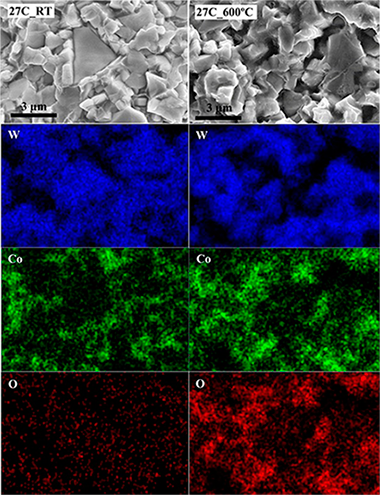
Abstract
The effect of the temperature on the mechanical strength of WC-Co cemented carbides with different microstructures (grain size and binder content) was evaluated. Biaxial flexural tests were performed on three cemented carbide grades at 600 °C using the ball-on-three-balls (B3B) method. Results were interpreted by Weibull statistics and compared to biaxial strength results at room temperature. A detailed fractographic analysis, supported by Linear Elastic Fracture Mechanics, was performed to differentiate the nature and size of critical defects and the mechanism responsible for the fracture. A significant decrease in the mechanical strength (around 30%) was observed at 600 °C for all grades of cemented carbides. This fact was ascribed to the change in the critical flaw population from sub-surface (at room temperature) to surface defects, associated with the selective oxidation of Co. Additionally, an estimation of the fracture toughness at 600 °C was attempted for the three cemented carbides, based upon the B3B strength results, the corresponding number of the tested specimens fragments and the macroscopic area of the B3B fracture surfaces. The fracture toughness was not affected by the temperature, at least up to 600 °C. In addition, the good agreement with the Single Edge Notch Beam toughness data suggests the possibility of employing this approach for fracture toughness evaluation of brittle materials under different testing conditions.
Febrero, 2018 · DOI: 10.1016/j.ijrmhm.2017.11.003
Química de Superficies y Catálisis
Outstanding performance of rehydrated Mg-Al hydrotalcites as heterogeneous methanolysis catalysts for the synthesis of biodiesel
Navajas, A; Campo, I; Moral, A; Echave, J; Sanz, O; Montes, M; Odriozola, JA; Arzamendi, G; Gandia, LMFuel, 211 (2018) 173-181 DOI: 10.1016/j.fuel.2017.09.061
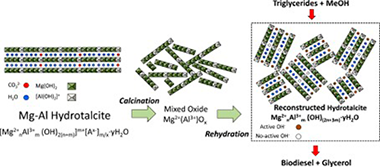
Abstract
There is still a need for active, selective and stable heterogeneous catalysts for the synthesis of biodiesel. In this work, magnesium-aluminium hydrotalcites with Mg/Al molar ratios within the 1.5-5 range were synthesized by coprecipitation and used as transesterification catalysts for the synthesis of biodiesel. The mixed oxides obtained after calcination recovered the hydrotalcite structure in the form of meixnerite after rehydration in boiling water. The solids were characterized by XRD, TGA, N-2 adsorption-desorption, and SEM. Basic properties were assessed by means of Hammett indicators and CO2-TPD. Rehydrated materials with the highest Mg/Al ratios showed some distinctive features: low surface area, well defined flake-like crystals, high basicity and strong basic sites with H_ values above 11. They were also the most active catalysts allowing to achieve 51-75% sunflower oil methanolysis conversion after 8 h of reaction under mild conditions (60 degrees C, 1 atm), methanol/oil molar ratio of 12 using between 2 and 6 wt% of catalyst. The conversion increased up to 96% (92% fatty acid methyl esters yield) using 2 wt% catalyst and methanol/oil molar ratio of 48. Catalyst leaching was not a serious problem with these solids that could be reutilized maintaining very good activities. A general accordance between solids basic properties and their catalytic performance has been observed. These results are among the best reported in the literature for heterogeneous methanolysis catalysts and have been attributed to the high basicity of the rehydrated solids and the presence of strong and accessible basic sites probably consisting in interlayer hydroxide anions at the edges of the crystals.
Enero, 2018 · DOI: 10.1016/j.fuel.2017.09.061
Materiales y Procesos Catalíticos de Interés Ambiental y Energético
Ir-Catalysed Nitrous oxide (N2O) Decomposition: Effect of Ir Particle Size and Metal-Support Interactions
Yentekakis, IV; Goula, G; Kampouri, S; Betsi-Argyropoulou, I; Panagiotopoulou, P; Taylor, MJ; Kyriakou, G; Lambert, RMCatalysis Letters, 148 (2019) 341-347 DOI: 10.1007/s10562-017-2233-z

Abstract
The effect of the morphology of Ir particles supported on.-Al2O3, 8 mol% Y2O3-stabilized -ZrO2 (YSZ), 10 mol%Gd2O3-doped CeO2 (GDC) and 80 wt%Al2O3-10 wt%CeO2-10 wt%ZrO2 (ACZ) on their stability on oxidative conditions, the associated metal-support interactions and activity for catalytic decomposition of N2O has been studied. Supports with intermediate or high oxygen ion lability (GDC and ACZ) effectively stabilized Ir nanoparticles against sintering, in striking contrast to supports offering negligible or low oxygen ion lability (gamma-Al2O3 and YSZ). Turnover frequency studies using size-controlled Ir particles showed strong structure sensitivity, de-N2O catalysis being favoured on large catalyst particles. Although metallic Ir showed some de-N2O activity, IrO2 was more active, possibly present as a superficial overlayer on the iridium particles under reaction conditions. Support-induced turnover rate modifications, resulted from an effective double layer [O delta--delta(+)](Ir) on the surface of iridium nanoparticles, via O2- backspillover from the support, were significant in the case of GDC and ACZ.
Enero, 2018 · DOI: 10.1007/s10562-017-2233-z
Reactividad de Sólidos
Core-rim structure formation in TiC-Ni based cermets fabricated by a combined thermal explosion/hot-pressing process
Lemboub, S; Boudebane, S; Gotor, FJ; Haouli, S; Mezrag, S; Bouhedja, S; Hesser, G; Chadli, H; Chouchane, TInternational Journal of Refractory Metals & Hard Materials, 70 (2018) 84-92 DOI: 10.1016/j.ijrmhm.2017.09.014
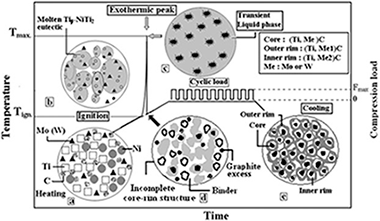
Abstract
TiC-Ni-based cermets were obtained by thermal explosion from different elemental mixtures (Ti, C, Ni and X, where X = Cr, Mo or W) and subsequently densified by hot-pressing under a cyclic load. The whole process was performed in a single stage in the same experimental device according to the following thermal and pressure procedure: a heating rate ramp up to 1573 K without applying any load followed by an isothermal dwelling under a compressive cyclic load of 32 MPa. The thermal explosion synthesis occurred during the heating ramp at a temperature close to 1273 K that was practically independent of the starting nominal composition. The influence of different refractory elements on the chemical composition and microstructure of cermets was studied. SEM characterization showed that only with Mo and W, the cermets developed the characteristic core-rim structure. A high densification was achieved, but decreased when the refractory elements were added. Nevertheless, in these cases higher hardness values were obtained.
Enero, 2018 · DOI: 10.1016/j.ijrmhm.2017.09.014
Reactividad de Sólidos
A new combustion route for synthesis of TaB2 nanoparticles
Jalaly, M; Gotor, FJCeramics International, 44 (2018) 1142-1146 DOI: 10.1016/j.ceramint.2017.10.074
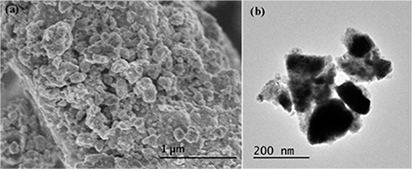
Abstract
Tantalum diboride (TaB2) nanoparticles were synthesized through a mechanically induced self-sustaining reaction (MSR). In this method, the ternary system of Mg/Ta2O5/B was employed in which, magnesium was used as a reducing agent for reduction of tantalum oxides in a combustive regime. The processing route of TaB2 by the solid-state combustion was very short-term and the product purification was extremely easy and rapid. The synthesis mechanism was studied and revealed that magnesiothermic reduction of tantalum oxide is the initiator of the total reaction, while borothermic reduction of the oxide may occur in parallel.
Enero, 2018 · DOI: 10.1016/j.ceramint.2017.10.074
Materiales Ópticos Multifuncionales
Flexible and Adaptable Light-Emitting Coatings for Arbitrary Metal Surfaces based on Optical Tamm Mode Coupling
Jiménez-Solano, A.; Galisteo-López, J.; Míguez, H.Advanced Optical Materials, 6 (2018) 1700560 DOI: 10.1002/adom.201700560
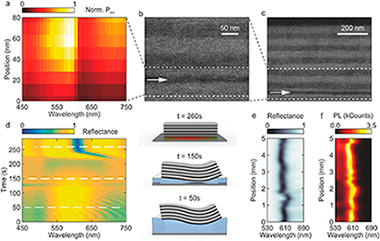
Abstract
This study demonstrates a design that maximizes the power radiated into free space from a monolayer of nanoemitters embedded in a flexible distributed Bragg reflector conformably attached to a metal surface. This is achieved by positioning the light source at the precise depth within the multilayer for which optical Tamm states provide enhanced quantum yield and outcoupling efficiency, which are combined to optimize the luminous power radiated by the surface of the ensemble. This approach, based on the adhesion of flexible multilayer stacks onto metal surfaces with an arbitrary curvature, is versatile and permits the realization of spectrally narrow monodirectional or self-focusing light-emitting surfaces.
Enero, 2018 · DOI: 10.1002/adom.201700560
Materiales para Bioingeniería y Regeneración Tisular
Nanostructured hybrid device mimicking bone extracellular matrix as local and sustained antibiotic delivery system
Borrego-Gonzalez, S; Romero-Sanchez, LB; Blazquez, J; Diaz-Cuenca, AMicroporous and Mesoporous Materials, 256 (2018) 165-176 DOI: 10.1016/j.micromeso.2017.08.010
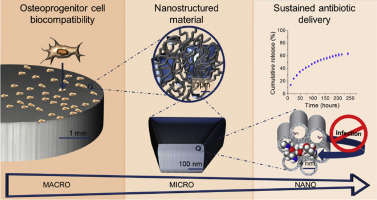
Abstract
A fluidic permeable and stable in wet media, MBG-NfGel, device consisting of a mesoporous ceramic embodied in a nanofibrillar biodegradable polymer has been processed using appropriate thermally induced phase separation (TIPS) processing variables of 5.4% (wt/v) gelatin in 50/50 water/ethanol (v/v) ratio. The device comprises high surface area mesoporous bioactive glass (MBG) microparticles within a fibrous matrix of 170 nm average diameter nanofibers gelatin, forming a meshwork of 0.2-1.6 mu m range voids. Gentamicin sulphate (GS) antibiotic high loading capacity and sustained release ability, as well as in vitro bioactivity and osteoprogenitor cells biocompatibility supports long-term antibacterial and bone growth stimulation properties. Antibiotic local delivery functionality in vitro of this device has been analysed and discussed in relation to other systems previously reported. The presented device properties as well as its industrial scalability potential, in terms of process reliability and absence of toxic chemical agents, low raw material biopolymer cost and immunogenicity, are other important advantages. These advantages rank MBG-NfGel device as a potential candidate to further development for application as local antibiotic device in bone surgery and therapy.
Enero, 2018 · DOI: 10.1016/j.micromeso.2017.08.010
Materiales y Procesos Catalíticos de Interés Ambiental y Energético
Phase-Contact Engineering in Mono- and Bimetallic Cu-Ni Co-catalysts for Hydrogen Photocatalytic Materials
Munoz-Batista, MJ; Meira, DM; Colon, G; Kubacka, A; Fernandez-Garcia, MAngewandte Chemie-International Edition, 57 (2018) 1199-1203 DOI: 10.1002/anie.201709552
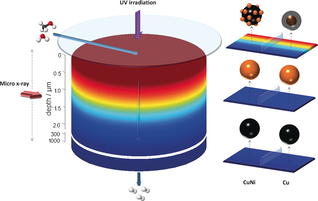
Abstract
Understanding how a photocatalyst modulates its oxidation state, size, and structure during a photocatalytic reaction under operando conditions is strongly limited by the mismatch between (catalyst) volume sampled by light and, to date, the physicochemical techniques and probes employed to study them. A synchrotron micro-beam X-ray absorption spectroscopy study together with the computational simulation and analysis (at the X-ray cell) of the light-matter interaction occurring in powdered TiO2-based monometallic Cu, Ni and bimetallic CuNi catalysts for hydrogen production from renewables was carried out. The combined information unveils an unexpected key catalytic role involving the phase contact between the reduced and oxidized non-noble metal phases in all catalysts and, additionally, reveals the source of the synergistic Cu-Ni interaction in the bimetallic material. The experimental method is applicable to operando studies of a wide variety of photocatalytic materials.
Enero, 2018 · DOI: 10.1002/anie.201709552
Reactividad de Sólidos
The dizinc bond as a ligand: A computational study of elongated dizinc bonds
Ayala, R; Carmona, E; Galindo, AInorganic Chimica Acta, 470 (2018) 197-205 DOI: 10.1016/j.ica.2017.06.008
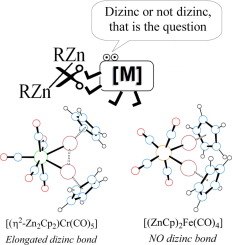
Abstract
Following the synthesis of [Zn-2(eta(2)-C5Me5)(2)] (in short [Zn2Cp*(2)]) many complexes of the directly bonded Zn-Zn unit were prepared and characterized, leading to the recognition of an isolobal analogy between the Zn-Zn bond and the molecule of dihydrogen. Prompted by these results, we have investigated eta(2)-eta(2)-coordination of [Zn2Cp2] and [Zn2Ph2] (Cp = C5H5, Ph = C6H5) to several selected transition metal fragments and report herein the results of a QTAIM study of complexes [(ZnR)(2)Fe(CO)(4)], [(eta(2)-Zn2R2)M(CO)(5)]] and [(eta(2)-Zn2R2)Pd(PR'(3))(2)] (for R = Cp, Ph; M = Cr, Mo, W; and R' = F, H, Me). A decrease of rho(BCP), Delta(2) rho(BCP) and delocalization indexes delta(Zn, Zn), relative to corresponding values in the parent molecules of [Zn2Cp2] and [Zn2Ph2], accompanied dizinc coordination. In most cases the computed d(Zn, Zn) parameters were indicative of significant electron density sharing between the two Zn atoms. Nevertheless, the interaction with [Fe(CO)(4)] resulted in oxidative cleavage of the coordinated Zn-Zn bond, due to high pi backdonation to the sigma* Zn-2 MO as deduced from the delta(M, O-CO) index. The Zn-Zn bond critical points identified in our study are discussed. The computed Zn-Zn contacts concentrate in the range 2.44-2.58 angstrom, and we propose that this interval corresponds to elongated dizinc bonds.
Enero, 2018 · DOI: 10.1016/j.ica.2017.06.008
Reactividad de Sólidos
Low-cost Ca-based composites synthesized by biotemplate method for thermochemical energy storage of concentrated solar power
Benitez-Guerrero, M; Valverde, JM; Perejon, A; Sanchez-Jimenez, PE; Perez-Maquecla, LAApplied Energy, 210 (2018) 108-116 DOI: 10.1016/j.apenergy.2017.10.109
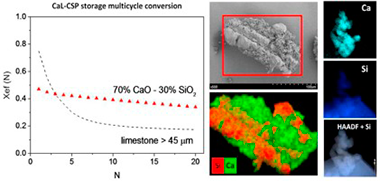
Abstract
An ever more environmentally conscious society demands the use of green, sustainable and high-efficiency renewable energy resources. However, large-scale energy storage remains a challenge for a deep penetration of power produced from renewables into the grid. The Calcium-Looping (CaL) process, based on the reversible carbonation/calcination of CaO, is a promising technology for thermochemical energy storage (TCES) in Concentrated Solar Power (CSP) plants. Natural limestone to be used as CaO precursor is cheap, non-toxic and abundant. Nevertheless, recent works have shown that carbonation of CaO derived limestone at optimum conditions for TCES is limited by pore-plugging, which leads to severe deactivation for large enough particles to be employed in practice. In our work, we have synthesized inexpensive CaO/SiO2 composites by means of a biotemplate method using rice husk as support. The morphological and compositional features of the biomorphic materials synthesized help improve the CaO multicycle activity under optimum CSP storage conditions and for particles sufficiently large to be managed in practical processes.
Enero, 2018 · DOI: 10.1016/j.apenergy.2017.10.109
Materiales y Procesos Catalíticos de Interés Ambiental y Energético
Nickel Particles Selectively Confined in the Mesoporous Channels of SBA-15 Yielding a Very Stable Catalyst for DRM Reaction
Rodriguez-Gomez, A; Pereniguez, R; Caballero, AJournal of Physical Chemistry B, 122 (2018) 500-510 DOI: 10.1021/acs.jpcb.7b03835
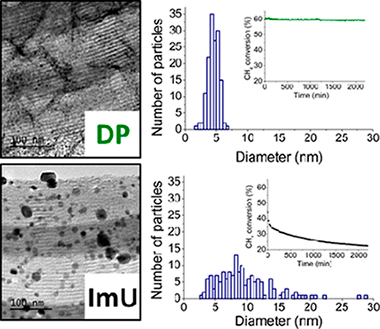
Abstract
A series of four Ni catalysts supported on SBA-15 and on a high SiO2 surface area have been prepared by modified impregnation (ImU) and deposition-precipitation (DP) methods. The catalysts have been extensively characterized, including in situ XAS (bulk sensitive) and XPS (surface sensitive) techniques, and their catalytic activities evaluated in the dry reforming reaction of methane (DRM). The combined use of XPS and XAS has allowed us to determine the location of nickel particles on each catalyst after reduction at high temperature (750 degrees C). Both Ni/SiO2-DP and Ni/SBA-15-DP catalysts yield well-dispersed and homogeneous metallic phases mainly located in the mesoporosity of both supports. On the contrary, the Ni/SiO2-ImU and Ni/SBA-15-ImU catalysts present a bimodal distribution of the reduced nickel phase, with nickel metallic particles located out and into the mesoporous structure of SiO2 or the SBA-15 channels. The Ni/SBA-15-DP catalyst was found the most stable and performing system, with a very low level of carbon deposition, about an order of magnitude lower than the equivalent ImU catalyst. This outstanding performance comes from the confinement of small and homogeneous nickel particles in the mesoporous channels of SBA-15, which, in strong interaction with the support, are resistant to sintering and coke deposition during the demanding reaction conditions of DRM.
Enero, 2018 · DOI: 10.1021/acs.jpcb.7b03835
Nanotecnología en Superficies y Plasma
Microstructural engineering and use of efficient poison resistant Au-doped Ni-GDC ultrathin anodes in methane-fed solid oxide fuel cells
Garcia-Garcia, FJ; Yubero, F; Gonzalez-Elipe, AR; Lambert, RMInternational Journal of Refractory Metals & Hard Materials, 43 (2018) 885-893 DOI: 10.1016/j.ijhydene.2017.11.020
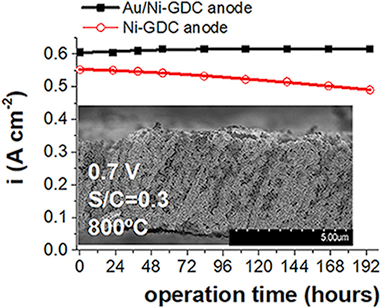
Abstract
Ultrathin porous solid oxide fuel cell (SOFC) anodes consisting of nickel-gadolinia-dopedceria (Ni-GDC) cermets with a unique porous micro-columnar architecture with intimate contact between the GDC and the Ni phases were made by magnetron sputtering at an oblique deposition angle and characterised in detail by a variety of methods prior to use in hydrogen or methane-fuelled SOFCs. These Ni-GDC anodes exhibited excellent transport properties, were robust under thermal cycling and resistant to delamination from the underlying yttria-stabilised zirconia electrolyte. Similarly prepared Au-doped Ni-GDC anodes exhibited the same morphology, porosity and durability. The gold associated exclusively with the Ni component in which it was present as a surface alloy. Strikingly, whatever their treatment, a substantial amount of Ce3+ persisted in the anodes, even after operation at 800 degrees C under fuel cell conditions. With hydrogen as fuel, the un-doped and Au doped Ni-GDC anodes exhibited identical electrochemical performances, comparable to that of much thicker commercial state-of-the-art Ni-GDC anodes. However, under steam reforming conditions with CH4/H(2)0 mixtures the behaviour of the Au-doped Ni-GDC anodes were far superior, exhibiting retention of good power density and dramatically improved resistance to deactivation by carbon deposition. Thus two distinct beneficial effects contributed to overall performance: persistence of Ce3+ in the working anodes could induce a strong metal-support interaction with Ni that enhanced the catalytic oxidation of methane, while formation of a Ni Au surface alloy that inhibited carbonisation and poisoning of the active nickel surface.
Enero, 2018 · DOI: 10.1016/j.ijhydene.2017.11.020
Reactividad de Sólidos
Corrigendum to “Dense graphene nanoplatelet/yttria tetragonal zirconia composites: Processing, hardness and electrical conductivity” [Ceram. Int. 43 (2017) 11743–11752]
Gallardo-Lopez, A; Marquez-Abril, I; Morales-Rodriguez, A; Munoz, A; Poyato, RCeramics International, 44 (2018) 1225-1225 DOI: 10.1016/j.ceramint.2017.10.015 (Correction)
Materiales de Diseño para la Energía y Medioambiente
Packing Defects in Fatty Amine Self-Assembled Monolayers on Mica as Revealed from AFM Techniques
Benitez, JJ; Heredia-Guerrero, JA; San-Miguel, MA; Galloway, HCJournal of Physical Chemistry B, 122 (2018) 493-499 DOI: 10.1021/acs.jpcb.7b03603
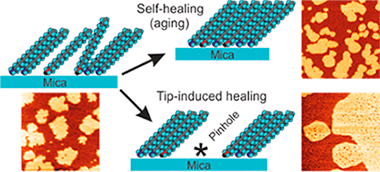
Abstract
Self-assembled monolayers of n-octadecylamine (ODA-SAMs) on mica have been prepared and studied by contact and jumping mode atomic force microscopy (AFM). Adhesion and friction data show that the compactness of the monolayers spontaneously increases as they are allowed to ripen. Molecular packing can also be induced by the controlled mechanical perturbation exerted by the probe when getting into and out of contact intermittently. Under these conditions, defects and vacancies aggregate giving rise to detectable pinholes uniformly distributed in AFM images. Created pinhole density was found to decrease with ripening time, thus confirming the proposed spontaneous self-healing mechanism. Pinhole density is also suggested as a parameter characterizing the packing degree of ODA-SAMs, and it has been related to their tribological properties. Additionally, molecular dynamics simulations were used to corroborate the compatibility between the packing degree and the observed topography of ODA-SAMs on mica.
Enero, 2018 · DOI: 10.1021/acs.jpcb.7b03603
Reactividad de Sólidos
Development of a novel fcc structure for an amorphous-nanocrystalline Ti-33Nb-4Mn (at.%) ternary alloy
Chicardi, E; Garcia-Garrido, C; Sayagues, MJ; Torres, Y; Amigo, V; Aguilar, CMaterials Characterization, 135 (2018) 46-56 DOI: 10.1016/j.matchar.2017.11.021
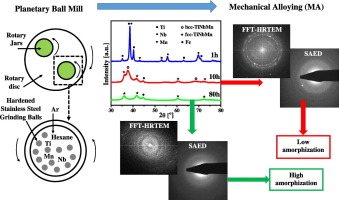
Abstract
In this work, a novel amorphous-nanocrystalline titanium-niobium-manganese solid solution ternary alloy with a Ti-33Nb-4Mn (at.%) nominal composition was developed by a High-Energy Mechanical Alloying. Nb and Mn were added to the elemental Ti as a beta-phase (bcc) stabilizer and an amorphization promoter, respectively. The system evolved from the elemental Ti, Nb and Mn raw materials to a body centred cubic (bcc) TiNbMn alloy and, finally, to the formation of an original and stable face centred cubic (fcc) nanocrystalline TiNbMn alloy, not reported until now, at short milling time (20 h). This alloy remains invariant until 120 h. In turn, the partial amorphization of the system occurs and increases until at intermediate milling time (80 h). The production of both original fcc and the amorphous TiNbMn alloy may be beneficial for reducing the Young's modulus and improving the mechanical strength pursued for the Ti alloy. The optimal milling time respect to the amorphization, nanocrystalline size and Fe mount from milling media was 60 h and 80 h (TiNbMn60h and TiNbMn80h), with > 50 wt% of an amorphous phase and a crystalline domain size of approximately 5 nm.
Enero, 2018 · DOI: 10.1016/j.matchar.2017.11.021
Reactividad de Sólidos - Fotocatálisis Heterogénea: Aplicaciones
A facile shape-controlled synthesis of highly photoactive fluorine containing TiO2 nanosheets with high {001} facet exposure
Lara, M.A.; Sayagués, M.J.; Navío, J.A.; Hidalgo, M.C.Journal of Materials Science, 53 (2018) 435-446 DOI: 10.1007/s1085
Abstract
Surface-fluorinated TiO2 materials with high {001} facet exposure were prepared by a simple and high-yield preparation procedure. Faceted/fluorinated samples showed a high photocatalytic performance not only in oxidation processes, tested in phenol and methyl orange degradation, but also in a reduction process as Cr(VI) photoreduction. Reaction rates for these materials greatly exceeded the ones obtained for materials prepared without fluorine addition and for commercial TiO2 Degussa (Evonik) P25 used as reference photocatalyst. A broad characterisation of the samples allowed us to estimate the percentages of different facets and the amount and form in which the fluorine is found on the surfaces. Good photocatalytic behaviour can be ascribed to both high {001} facet exposure and adsorbed fluorine on the photocatalysts surfaces.
Enero, 2018 · DOI: 10.1007/s1085
Propiedades mecánicas, modelización y caracterización de cerámicos avanzados
High temperature creep of 20 vol%. SiC-HfB2 UHTCs up to 2000 degrees C and the effect of La2O3 addition
Zapata-Solvas, E; Gomez-Garcia, D; Dominguez-Rodriguez, A; Lee, WEJournal of the European Ceramic Society. 38 (2018) 47-56 DOI: 10.1016/j.jeurceramsoc.2017.08.028
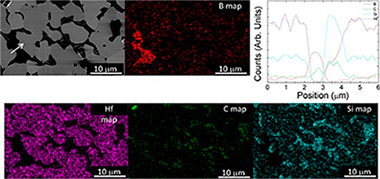
Abstract
High temperature compressive creep of SiC-HfB2 UHTCs up to 2000 °C has been studied. Microstructural analysis after deformation reveals formation of new phases in the Hf-B-Si and Hf-B-Si-C systems, which are responsible for the poor creep resistance. RE oxide additions have a negative effect reducing the creep resistance of SiC-HfB2 UHTCs. A simplistic analysis for the required creep resistance is described, indicating that only SiC-HfB2 UHTCs could withstand re-entry conditions for 5 min in a single use. However, RE oxide addition to SiC-HfB2UHTCs does not provide the required creep resistance for them to be candidate materials for hypersonic applications.
Enero, 2018 · DOI: 10.1016/j.jeurceramsoc.2017.08.028
Fotocatálisis Heterogénea: Aplicaciones
Enhanced photocatalytic removal of phenol from aqueous solutions using ZnO modified with Ag
Vaiano, V.; Matarangolo, M.; Murcia, J.J.; Rojas, H.; Navío, J.A.; Hidalgo, M.C.Applied Catalysis B-Environmental, 225 (2018) 197-206 DOI: 10.1016/j.apcatb.2017.11.075
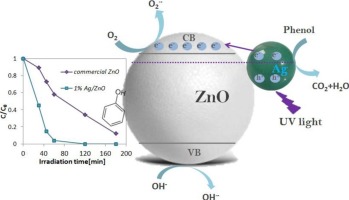
Abstract
Different photocatalysts based on commercial ZnO modified by silver photodeposition were prepared in this work. The samples were characterized by X-ray fluorescence spectrometry (XRF), specific surface area (SSA), transmission electron microscopy (TEM), X-ray photoelectron spectroscopy (XPS), X-ray diffraction (XRD) and UV–vis diffuse reflectance (UV–vis DRS). XRD and XPS showed that Ag/ZnO samples are composed of metallic Ag (Ag0) and ZnO structure was identified. Furthermore, TEM analysis evidenced that the number of silver particles increased with the Ag content. At last, UV–vis DRS results revealed a reflectance band for Ag/ZnO samples, ascribed to the surface plasmon resonance (SPR) absorption of metal silver particles. Commercial ZnO and Ag/ZnO samples were evaluated in the phenol removal under UV light irradiation. It was observed an enhancement of photocatalytic phenol removal from aqueous solutions by silver addition in comparison to commercial ZnO. In particular, the phenol removal increased with the silver content from 0.14 to 0.88 wt%, after this content (i.e 1.28 wt%) the phenol degradation significantly decreased indicating that the optimal Ag content was equal to 0.88 wt%. The influence of the best photocatalyst dosage and the change of the initial phenol concentration in solution were also investigated in this work and the best photocatalytic performance was obtained by using 50 mg L−1 of phenol initial concentration and 0.15 g L−1 of photocatalyst dosage. Finally, the optimized Ag/ZnO photocatalyst was employed for the treatment of a real drinking wastewater containing phenol in which the almost total phenol removal was achieved after 180 min of UV irradiation time.
Enero, 2018 · DOI: 10.1016/j.apcatb.2017.11.075
Nanotecnología en Superficies y Plasma
Nickel/Copper Bilayer-modified Screen Printed Electrode for Glucose Determination in Flow Injection Analysis
Salazar, P.; Rico, V.; Gonzalez-Elipe, Agustin R.Electroanalysis, 30 (2018) 187-193 DOI: 10.1002/elan.201700592
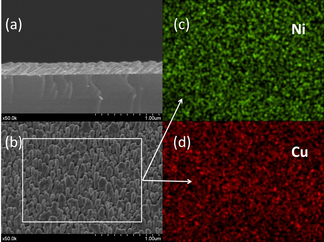
Abstract
This work reports about the performance of a Ni/Cu-modified screen printed electrodes (SPE/Ni/Cu), prepared by physical vapor deposition (PVD) in an oblique angle configuration (OAD), for non-enzymatic glucose sensing applications. SPE/Ni/Cu electrodes showed an excellent reversibility and a catalytic behavior for detection of glucose that were controlled by the diffusion of reactants up to the active sites at the electrode surface. The study with a flow injection analysis (FIA) setup of the main experimental variables affecting the detection process has shown that the developed electrode system had an excellent glucose sensitivity of 1.04AM(-1)cm(-2) (R-2:0.999), a linear response up to 1mM, a limit of detection of 0.33M and a time of analysis of ca. 30s per sample. The selectivity of the sensor was checked against various interferences, including ascorbic acid, uric acid, acetaminophen and other sugars, in all cases with excellent results. The feasibility of using this sensor for practical applications was successfully confirmed by determining the glucose concentration in different commercial beverages.
Enero, 2018 · DOI: 10.1002/elan.201700592
2017
2017
Nanotecnología en Superficies y Plasma
Silver and gold nanoparticles in nanometric confined templates: synthesis and alloying within the anisotropic pores of oblique angle deposited films
Parra-Barranco, J., Sánchez-Valencia, J.R., Barranco, A., González-Elipe, A.R.Nanotechnology, 28 (2017) 485602 DOI: 10.1088/1361-6528/aa92af
Abstract
In this work we have developed an infiltration methodology to incorporate metal nanoparticles (NPs) of controlled size and shape into the open voids available in oblique angle deposited thin films. These NPs exhibited well-defined surface plasmon resonances (SPRs). The nanometric confined space provided by their porous microstructure has been used as a template for the growth of anisotropic NPs with interesting SPR properties. The fabrication methodology has been applied for the preparation of films with embedded Ag and Au NPs with two associated plasmon resonance features that developed a dichroic behaviour when examined with linearly polarized light. A confined alloying process was induced by near IR nanosecond laser irradiation yielding bimetallic NPs with SPR features covering a large zone of the electromagnetic spectrum. The possibilities of the method for the tailored fabrication of a wide range colour palette based on SPR features are highlighted.
Diciembre, 2017 · DOI: 10.1088/1361-6528/aa92af
Reactividad de Sólidos
Chalcogenide Quaternary Cu2FeSnS4 Nanocrystals for Solar Cells: Explosive Character of Mechanochemical Synthesis and Environmental Challenge
Balaz, P; Balaz, M; Sayagues, MJ; Eliyas, A; Kostova, NG; Kanuchova, M; Dutkova, E; Zorkovska, ACrystals, 7 (2017) art. 367 DOI: 10.3390/cryst7120367
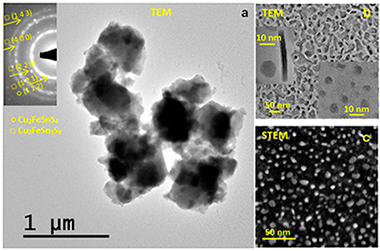
Abstract
In this study we demonstrate the synthesis of quaternary semiconductor nanocrystals of stannite Cu2FeSnS4/rhodostannite Cu2FeSn3S8 (CFTS) via mechanochemical route using Cu, Fe, Sn and S elements as precursors in one-pot experiments. Methods of X-ray diffraction (XRD), nitrogen adsorption, high-resolution transmission electron microscopy (HRTEM), scanning transmission electron microscopy (STEM), energy-dispersive X-ray spectroscopy (EDX) and X-ray photoelectron spectroscopy (XPS) were applied to characterize properties of the unique nanostructures. Mechanochemical route of synthesis induced new phenomena like explosive character of reaction, where three stages could be identified and the formation of nanostructures 5-10 nm in size. By using XPS method, Cu(I), Fe(II), Sn(IV) and S(-II) species were identified on the surface of CFTS. The value of optical band gap 1.27 eV is optimal for semiconductors applicable as absorbers in solar cells. The significant photocatalytic activity of the CFTS nanocrystals was also evidenced. The obtained results confirm the excellent properties of the quaternary semiconductor nanocrystals synthesized from earth-abundant elements.
Diciembre, 2017 · DOI: 10.3390/cryst7120367
Materiales Coloidales
Local Disorder and Tunable Luminescence in Sr1–x/2Al2–xSixO4 (0.2 ≤ x ≤ 0.5) Transparent Ceramics
Fernandez-Carrion, AJ; Al Saghir, K; Veron, E; Becerro, AI; Porcher, F; Wisniewsld, W; Matzen, G; Fayon, F; Allix, MInorganic Chemistry, 56 (2017) 14446-14458 DOI: 10.1021/acs.inorgchem.7b01881
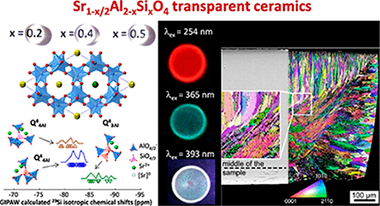
Abstract
Eu-doped Sr1–x/2Al2–xSixO4 (x = 0.2, 0.4, and 0.5) transparent ceramics have been synthesized by full and congruent crystallization from glasses prepared by aerodynamic levitation and laser-heating method. Structural refinements from synchrotron and neutron powder diffraction data show that the ceramics adopt a 1 × 1 × 2 superstructure compared to the SrAl2O4 hexagonal polymorph. While the observed superstructure reflections indicate a long-range ordering of the Sr vacancies in the structure, 29Si and 27Al solid-state NMR measurements associated with DFT computations reveal a significant degree of disorder in the fully polymerized tetrahedral network. This is evidenced through the presence of Si–O–Si bonds, as well as Si(OAl)4 units at remote distances of the Sr vacancies and Al(OAl)4 units in the close vicinity of Sr vacancies departing from local charge compensation in the network. The transparent ceramics can be doped by europium to induce light emission arising from the volume under UV excitation. Luminescence measurements then reveal the coexistence of Eu2+ and Eu3+ in the samples, thereby allowing tuning the emission color depending on the excitation wavelength and suggesting possible applications such as solid state lighting.
Diciembre, 2017 · DOI: 10.1021/acs.inorgchem.7b01881
Reactividad de Sólidos
Effect of acid-treatment and colloidal-processing conditions on the room temperature mechanical and electrical properties of 3YTZP/MWNT ceramic nanocomposites
Poyato, R.; Morales-Rodríguez, A.; Gutiérrez-Mora, F.; Muñoz, A.; Gallardo-López, A.Ceramics International, 43 (2017) 16560-16568 DOI: 10.1016/j.ceramint.2017.09.043
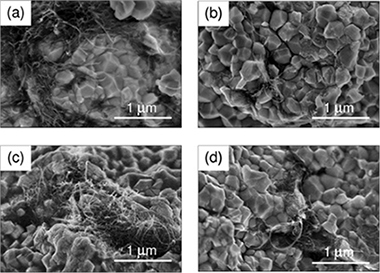
Abstract
Different colloidal powder processing routines have been used to prepare composites of 3 mol% Y2O3 -ZrO2 (tetragonal zirconia polycrystals, 3YTZP) with 2.5 vol% multiwall carbon nanotubes (MWNT) with the aim of achieving a homogeneous distribution of the MWNTs in the ceramic, eliminating agglomerates but also minimizing carbon nanotube (CNT) damage during processing. Modifications of the acid treatment applied to the nanotubes, including subjecting them to stirring or ultrasonic agitation, and use of acid or basic pH during composite powder mixing have been approached.
No MWNT damage during processing was detected by Raman spectroscopy. CNT bundles were found in all the composites forming different patterns depending on the processing route. Similar values of hardness were obtained for all the composites, while different anisotropy in fracture propagation was found when studying parallel and perpendicular directions to the sintering pressing axis on the cross sections of the composites due to the MWNT preferential alignment. The CNT bundles were found to act as fracture short paths. A similar anisotropic behavior was observed for the electrical conductivity. These results have been correlated to the different microstructures obtained in the composites prepared with different processing routines.
Diciembre, 2017 · DOI: 10.1016/j.ceramint.2017.09.043
Nanotecnología en Superficies y Plasma
Micron-scale wedge thin films prepared by plasma enhanced chemical vapor deposition
Lopez-Santos, MC; Alvarez, R; Palmero, A; Borras, A; del Campo, RC; Holgado, M; Gonzalez-Elipe, ARPlasma Processes and Polymers, 14 (2017) e1700043 DOI: 10.1002/ppap.201700043
Abstract
Wedge-shaped materials are currently employed for optical analyses and sensing applications. In this paper, we present an easy to implement plasma enhanced chemical vapor deposition procedure to grow wedge-shaped thin films with controlled slope at the scale of few hundred microns. The method relies on the use of few tenths micron height obstacles to alter the laminar flow of precursor gas during deposition and is applied for the fabrication of wedge-shaped ZnO thin films. Local interference patterns, refractive index, and birefringence of the films have been measured with one micron resolution using a specially designed optical set-up. Their micro- and nano-structures have been characterized by means of scanning electron microscopy and theoretically reproduced by Monte Carlo calculations.
Diciembre, 2017 · DOI: 10.1002/ppap.201700043
Materiales de Diseño para la Energía y Medioambiente
High temperature compressive strength and creep behavior of Si-Ti-C-O fiber-bonded ceramics
Vera, MC; Martinez-Fernandez, J; Singh, M; Ramirez-Rico, JJournal of the European Ceramic Society, 37 (2017) 4442-4448 DOI: 10.1016/j.jeurceramsoc.2017.06.037
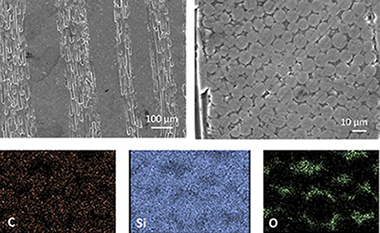
Abstract
Fiber bonded silicon carbide ceramic materials provide cost-advantage over traditional ceramic matrix composites and require fewer processing steps. Despite their interest in extreme environment thermostructural applications no data on long term mechanical reliability other than static fatigue is available for them. We studied the high temperature compressive strength and creep behavior of a fiber bonded SiC material obtained by hot-pressing of Si Ti-C-O fibers. The deformation mechanism and onset of plasticity was evaluated and compared with other commercial SiC materials. Up to 1400 degrees C, plasticity is very limited and any macroscopic deformation proceeds by crack formation and damage propagation. A transient viscous creep stage is observed due to flow in the silica matrix and once steady state is established, a stress exponent n similar to 4 and an activation energy Q similar to 700 kJ mol(-1) are found. These results are consistent with previous data on creep of polymer derived SiC fibers and polycrystals.
Diciembre, 2017 · DOI: 10.1016/j.jeurceramsoc.2017.06.037
Materiales de Diseño para la Energía y Medioambiente
Performance of biomorphic Silicon Carbide as particulate filter in diesel boilers
Orihuela, M Pilar; Gomez-Martin, Aurora; Becerra, Jose A; Chacartegui, Ricardo; Ramirez-Rico, JoaquinJournal of Environmental Management, 203 (2017) 907-919 DOI: 10.1016/j.jenvman.2017.05.003
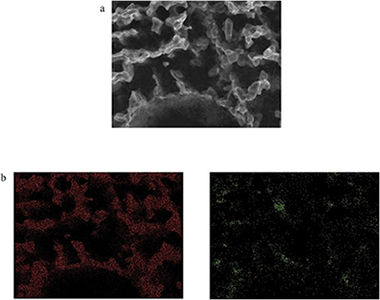
Abstract
Biomorphic Silicon Carbide (bioSiC) is a novel porous ceramic material with excellent mechanical and thermal properties. Previous studies have demonstrated that it may be a good candidate for its use as particle filter media of exhaust gases at medium or high temperature. In order to determine the filtration efficiency of biomorphic Silicon Carbide, and its adequacy as substrate for diesel particulate filters, different bioSiC-samples have been tested in the flue gases of a diesel boiler. For this purpose, an experimental facility to extract a fraction of the boiler exhaust flow and filter it under controlled conditions has been designed and built. Several filter samples with different microstructures, obtained from different precursors, have been tested in this bench. The experimental campaign was focused on the measurement of the number and size of particles before and after placing the samples. Results show that the initial efficiency of filters made from natural precursors is severely determined by the cutting direction and associated microstructure. In biomorphic Silicon Carbide derived from radially cut wood, the initial efficiency of the filter is higher than 95%. Nevertheless, when the cut of the wood is axial, the efficiency depends on the pore size and the permeability, reaching in some cases values in the range 70–90%. In this case, the presence of macropores in some of the samples reduces their efficiency as particle traps. In continuous operation, the accumulation of particles within the porous media leads to the formation of a soot cake, which improves the efficiency except in the case when extra-large pores exist. For all the samples, after a few operation cycles, capture efficiency was higher than 95%. These experimental results show the potential for developing filters for diesel boilers based on biomorphic Silicon Carbide.
Diciembre, 2017 · DOI: 10.1016/j.jenvman.2017.05.003
Materiales Coloidales
Microemulsion-Mediated Synthesis and Properties of Uniform Ln:CaWO4 (Ln = Eu, Dy) Nanophosphors with Multicolor Luminescence for Optical and CT Imaging
Laguna, M; Nuñez, NO; Garcia, FJ; Corral, A; Parrado-Gallego, A; Balcerzyk, M; Becerro, AI; Ocaña, MEuropean Journal of Inorganic Chemistry, 44 (2017) 5158-5168 DOI: 10.1002/ejic.201700650
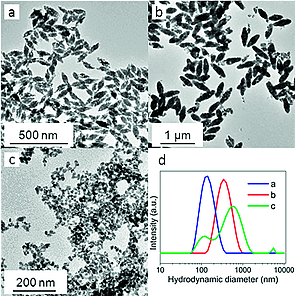
Abstract
A new room-temperature method has been developed that yields, for the first time in the literature, uniform and well-dispersed CaWO4 nanospindles. This method is based on the use of microemulsions consisting of aqueous solutions of Ca2+ and WO42- precursors, cyclohexane as the organic medium, Triton X-100 as the surfactant, and n-octanol as the cosurfactant. We show that the formation of uniform nanospindles requires a restrictive set of experimental conditions. These particles crystallize into the tetragonal CaWO4 phase and emit blue-green luminescence when excited by UV radiation. The reported method is also useful for doping the CaWO4 spindles with Eu3+ or Dy3+ cations, resulting in multicolor emissions (red for Eu3+; white for Dy3+). The luminescence is much stronger when excited through a WO42--Ln(3+) (Ln = Eu or Dy) energy-transfer band than through the f-f transition bands of the Ln(3+) cations. Interestingly, because of the white luminescence associated with the Dy:CaWO4 nanophosphor, it might be useful for LED technologies. Luminescence dynamics and energy-transfer efficiency have been analyzed to determine the optimum phosphors. Finally, the Eu-doped CaWO4 nanospindles also showed excellent X-ray attenuation efficacy, which confers double functionality to this material as both a luminescence bioprobe and as a contrasting agent for X-ray computed-tomography.
Diciembre, 2017 · DOI: 10.1002/ejic.201700650
Materiales Ópticos Multifuncionales
Fluorescent Humidity Sensors Based on Photonic Resonators
Szendrei, K; Jimenez-Solano, A; Lozano, G; Lotsch, BV; Miguez, HAdvanced Optical Materials, 5 (2017) 1700663 DOI: 10.1002/adom.201700663
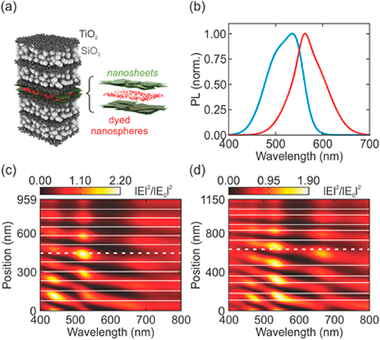
Abstract
Among the different approaches to humidity sensing available, those based on fluorescent signals are gathering a great deal of attention due to their fast response and versatility of detection and design. So far, all proposals have focused on the use of luminescent probes whose emission is either triggered or inhibited by the presence of water that reacts or alters their chemical environment, hence inducing the signal change. Here, a novel concept in fluorescent humidity sensing based on combining stimuli-responsive photonic resonators with molecular fluorescent probes is introduced. The resonator is assembled from humidity-swellable antimony phosphate nanosheets embedding a planar light-emitting probe, whose emission is dramatically modified by the changes that ambient humidity causes in its photonic environment. Guided by "in silico" optical design of the resonator architecture and subsequent experimental realization, two embodiments of fluorescent photonic humidity sensors featuring turn-on and turn-off detection schemes are presented. The interplay between the luminescent properties of an emitter and its photonic environment implies a fundamental advantage as the emitters are not chemically altered during the detection process. At the same time, it paves the way toward a new generation of photonic humidity sensors which can conveniently be interfaced with common fluorescence detection schemes.
Diciembre, 2017 · DOI: 10.1002/adom.201700663
- ‹ anterior
- 17 of 37
- siguiente ›




